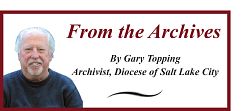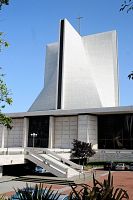A Bit of History About 'McGucken's Maytag'
The seasons of Advent and Christmas bring us a bounty of Marian celebrations: the Immaculate Conception, Christmas itself, of course, the Holy Family, and the Solemnity of Mary the Mother of God on Jan. 1. So, this month I offer some thoughts about the mother church of the Archdiocese of San Francisco, the Cathedral of St. Mary of the Assumption.
San Francisco Catholics – and I count us among them because we are part of the Metropolitan Ecclesiastical Province of San Francisco – have occasionally had a rough ride with the archbishops assigned to us. While some have been outstanding, and we can count Archbishops John R. Quinn and George H. Niederauer of recent memory among them, others have been widely disliked. One particularly rough period extended from 1932 to 1977, including the terms of Archbishops John J. Mitty (1932-61) and Joseph T. McGucken (1962-77).
Archbishop Mitty had been the Bishop of Salt Lake City from 1926 to 1932. His whiplash administrative style had been exactly what the diocese needed to begin getting us out of the financial destitution in which he had found it, and back on the road to solvency. But he had made enemies, and continued to make them after he was sent to San Francisco. His clergy let out a sigh of relief when he died in 1961, but they had to stifle it early the following year when they learned that Archbishop Mitty had been replaced by Archbishop Joseph T. McGucken. Archbishop McGucken, in their view, might not have been as distasteful as Archbishop Mitty, but he wasn’t much better either. Some of those clergy, with an evident taste for the vulgar, applied to those archbishops nicknames derived from four-letter words. (Because this is a family newspaper, I will not divulge those nicknames here.)
Tragedy struck only eight months into Archbishop McGucken’s episcopal term when St. Mary’s Cathedral, which had been dedicated in 1891, caught fire and burned to the ground. Like it or not, his legacy would be to create a new cathedral.
Rather than rebuild on the old site, Archbishop McGucken chose a new location on a hilltop with a commanding view of the city and on the edge of the infamous Tenderloin district where homelessness, addiction and crime were rampant. It was the perfect place for the cathedral.
In the spirit of the new architectural guidelines of the Second Vatican Council, which was just then going on, the church was designed in a square, so that parishioners sit more or less around the altar rather than just in front of it.
To my mind, the best feature of the church is the big windows that extend around a large part of the perimeter, so that while sitting at Mass, one can see beyond the clergy and the altar and out the windows to a stunning panoramic view of the city beyond. The message one gets is that we’re not just here to hug and hold hands and congratulate each other on being the splendid Catholics we are, but rather to get our spiritual batteries charged so we can get out there on the other side of the windows and minister to a suffering world.
There is a large bronze bust of Archbishop McGucken in the lower level of the cathedral. It is a richly deserved memorial.
Although St. Mary’s Cathedral has become one of San Francisco’s architectural landmarks, it is not without its oddities. Primary among those is a great tower in the shape of a cross that extends high up from the center of the church. Viewed from the air, it resembles nothing so much as the impeller on an old-fashioned washing machine. The archbishop’s unflinching critics have dubbed it “McGucken’s Maytag.”
We don’t have any Maytags in our diocese, but we do have churches with windows out onto the world. At a funeral recently at St. Catherine of Siena Parish, I noted that I could see out onto University Street through the windows on either side of the sanctuary. Those people out there driving and walking around are a large part of the reason why we were there at Mass.
Gary Topping is the archivist for the Diocese of Salt Lake City.
© Copyright 2024 The Diocese of Salt Lake City. All rights reserved.



Stay Connected With Us